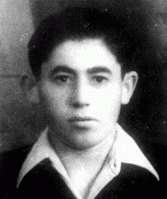You searched for: DEATH MARCH
<< Previous | Displaying results 51-75 of 410 for "DEATH MARCH" | Next >>
-
The bodies of Jewish women exhumed from a mass grave near Volary
PhotoThe bodies of Jewish women exhumed from a mass grave near Volary. The victims died at the end of a death march from Helmbrechts, a subcamp of Flossenbürg. Germans were forced to exhume them in order to give the victims proper burial. Volary, Czechoslovakia, May 11, 1945.
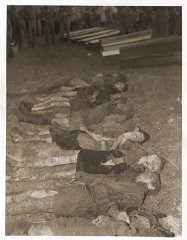
-
German civilians view a mass grave in Volary
PhotoUnder the supervision of American medics, German civilians file past the bodies of Jewish women exhumed from a mass grave in Volary. The victims died at the end of a death march from Helmbrechts, a subcamp of Flossenbürg. Germans were forced to exhume them in order to give the victims proper burial. Volary, Czechoslovakia, May 11, 1945.
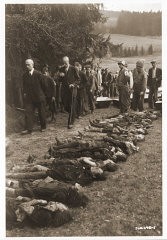
-
Nesse Galperin Godin describes her appearance at the time she was liberated
Oral HistoryNesse's family had a dairy business. The Germans occupied Lithuania in 1941 and established a ghetto in Siauliai. Nesse lived in the ghetto until 1943 when she was old enough to work. In 1944 Nesse, her mother, and a brother were deported to the Stutthof camp near Danzig. Nesse worked in several Stutthof subcamps until January 1945, when the inmates were put on a death march. She was liberated by the Soviets in March. Nesse, her mother, and two brothers survived, and she arrived in the United States in…
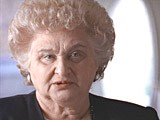
-
Moniek Rozen
ID CardOne of 12 children, Moniek grew up in Dabrowa Gornicza, an industrial town in western Poland. His father, Jacob, owned a general store, which he was forced to close in 1938 as the result of a boycott by local antisemites. Moniek attended both public and Jewish schools, and his father hoped that one day he would become a rabbi. 1933–39: On September 1, 1939, Moniek was awakened by the sounds of airplanes flying overhead as German forces invaded Poland. As the war drew closer, Moniek fled eastward, but…
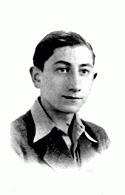
-
A US soldier stands among the corpses of prisoners exhumed from a mass grave near Nammering
PhotoA US soldier stands among the corpses of prisoners exhumed from a mass grave in a ravine near Nammering. On April 19, 1945, a freight train with nearly 4,500 prisoners from Buchenwald pulled onto the railroad siding at Nammering. Hundreds of prisoners who had died on the train were buried in the mass grave along with the prisoners who were forced to carry the corpses to the ravine and were then shot. Germany, ca. May 6, 1945.
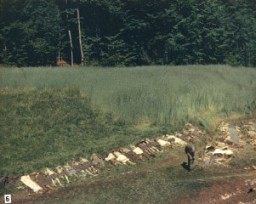
-
Yitzhak (Irving) Balsam
ID CardYitzhak was the second of four children born to religious Jewish parents. The family lived on the Polish-German border in Praszka, a small town where Yitzhak's father worked as a tailor. His work was not steady, and the family struggled to make ends meet. Yitzhak attended Polish public school in the mornings and Hebrew school in the afternoons. 1933-39: At 4 a.m. on September 1, 1939, the Balsams were awakened by an explosion. The Polish army had blown up the bridge over the Prosna River to impede the…

-
Charles Torluccio describes liberation and the role of medical staff
Oral HistoryCharles Torluccio is a veteran of the 11th Armored Division. During the invasion of German-held Austria, in May 1945 the 11th Armored (the "Thunderbolt" division) overran two of the largest Nazi concentration camps in the country: Mauthausen and Gusen.
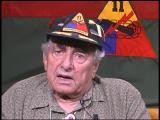
-
Sophie Weisz
ID CardSophie was born to a prosperous Jewish family in a village near the Hungarian border known for its winemaking and carriage wheel industries. The village had many Jewish merchants. Her father owned a lumber yard. Sophie loved to dance in the large living room of their home as her older sister, Agnes, played the piano. 1933-39: Sophie's father believed in a Jewish homeland and sent money to Palestine to plant trees and establish settlements there. When she was 10, she was sent to a school in nearby Oradea…
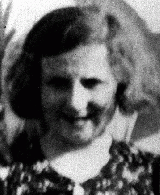
-
Magda Hellinger
ID CardMagda was the only daughter in a family of five children. Her town of Michalovce, in eastern Slovakia, was an agricultural trade center and it had a large Jewish population. Magda's father taught Jewish history in local Jewish schools. Magda grew up learning Hebrew songs and listening to stories about Jewish history. 1933-39: It's Magda's nature to work with people and to help them work together. In Michalovce she studied to become a kindergarten teacher, and worked to establish a new chapter of the…

-
Wilek (William) Loew describes forced evacuation from Auschwitz
Oral HistoryWilek was the son of Jewish parents living in the southeastern Polish town of Lvov. His family owned and operated a winery that had been in family hands since 1870. Wilek's father died of a heart attack in 1929. Wilek entered secondary school in 1939. Soon after he began school, World War II began with the German invasion of Poland. Lvov was in the part of eastern Poland annexed by the Soviet Union. Although the Soviets took over Wilek's home and the family business, Wilek was able to continue his…
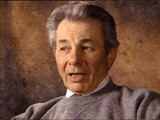
-
Rena Gani: Maps
Media EssayBorn to a Jewish family in Preveza, Rena Gani was endangered by the German occupation of Greece. In March 1944, the Nazis deported the Jews of Preveza to Auschwitz. Rena was later sent to the Ravensbrück camp and was liberated during a death march...
-
Burial services for the Jewish women exhumed from a mass grave in Volary
PhotoGerman civilians from Volary attend burial services for the Jewish women exhumed from a mass grave in the town. The victims died at the end of a death march from Helmbrechts, a subcamp of Flossenbürg. Germans were forced to exhume them in order to give the victims proper burial. Volary, Czechoslovakia, May 11, 1945.
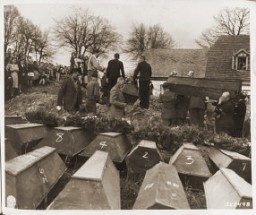
-
Yitzhak (Irving) Balsam: Maps
Media EssayYitzhak Balsam was just under 15 years old when Germany invaded Poland in September 1939. Like other Jewish men in Praszka, he was forced to build roads outside of town. Yitzhak was later deported to several camps, including Auschwitz, and was imp...
-
Gross-Rosen - Maps
Media EssayGross-Rosen became an independent concentration camp in 1941. The camp eventually expanded to become the center of an industrial complex and to include a vast network of at least 97 subcamps.
-
Forcible evacuation of prisoners from the Stutthof camp
PhotoFleeing the advance of the Soviet army, the Germans forcibly evacuated westward by barge these prisoners of the Stutthof concentration camp. Near Danzig, January 1945.

-
Meyer (Max) Rodriguez Garcia: Maps
Media EssayMeyer (Max) Rodriguez Garcia was born to a Jewish family in Amsterdam. Max was nearly 16 years old when Germany invaded the Netherlands in May 1940. He went into hiding in early 1943, but was caught by June and deported to Auschwitz in German-occu...
-
First page of Eva Ostwalt's cookbook
ArtifactEva Ostwalt was born in Cologne, Germany, to Jewish parents. She had two younger sisters, Kate and Trude. In 1927, Eva moved with her daughter, Heidemarie, and non-Jewish husband to Dresden. Eva and Karl later divorced, and Eva received custody of Heidemarie. Mother and daughter moved to Merano, Italy. When Eva’s passport expired in 1938, she had to return to Germany. Believing that Heidemarie would be safer with her father, Eva gave custody back to Karl in Dresden. Eva returned to Cologne, where both…

-
Page of recipes from Eva Ostwalt's cookbook
ArtifactEva Ostwalt was born in Cologne, Germany, to Jewish parents. She had two younger sisters, Kate and Trude. In 1927, Eva moved with her daughter, Heidemarie, and non-Jewish husband to Dresden. Eva and Karl later divorced, and Eva received custody of Heidemarie. Mother and daughter moved to Merano, Italy. When Eva’s passport expired in 1938, she had to return to Germany. Believing that Heidemarie would be safer with her father, Eva gave custody back to Karl in Dresden. Eva returned to Cologne, where both…
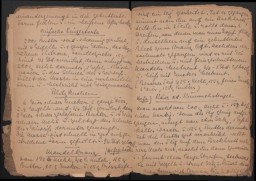
-
Recipes from Eva Ostwalt's cookbook
ArtifactEva Ostwalt was born in Cologne, Germany, to Jewish parents. She had two younger sisters, Kate and Trude. In 1927, Eva moved with her daughter, Heidemarie, and non-Jewish husband to Dresden. Eva and Karl later divorced, and Eva received custody of Heidemarie. Mother and daughter moved to Merano, Italy. When Eva’s passport expired in 1938, she had to return to Germany. Believing that Heidemarie would be safer with her father, Eva gave custody back to Karl in Dresden. Eva returned to Cologne, where both…
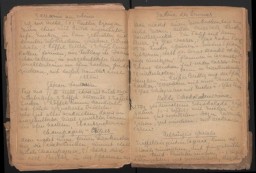
-
Evacuation of Prisoners from Sachsenhausen
Timeline EventApril 20-21, 1945. On this date, SS guards evacuated prisoners from the Sachsenausen concentration camp in Germany.

-
Chaim Frenkiel
ID CardChaim was the third of seven boys born to religious Jewish parents. They lived in a town near Warsaw called Gabin, where Chaim's father worked as a cap maker. Gabin had one of Poland's oldest synagogues, built of wood in 1710. Like most of Gabin's Jews, Chaim's family lived close to the synagogue. The family of nine occupied a one-room apartment on the top floor of a three-story building. 1933-39: In September 1939, two months before Chaim was 12, Germany invaded Poland. In Gabin 10 people were shot in…
